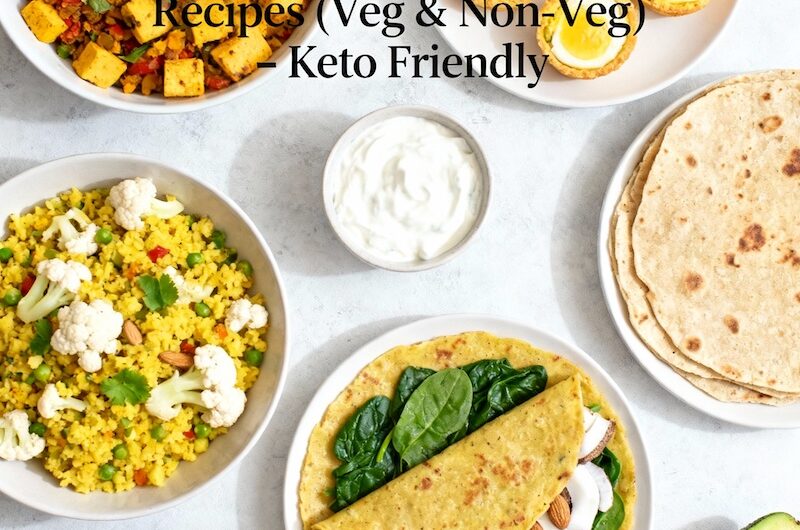Discover easy and tasty low-carb Indian breakfast recipes for keto — both vegetarian and non-vegetarian. Stay in ketosis without giving up flavor!
A low-carb Indian breakfast, whether vegetarian or non-vegetarian, can significantly change how your body feels, especially if you’re following a keto diet and aiming to maintain ketosis for weight loss or health. Indian cuisine has a lot of variety, and with a few smart choices, you can enjoy delicious meals that keep carbohydrates low and healthy fats high. Let’s explore some practical ideas and sample recipes for both vegetarians and non-vegetarians, keeping everything easy to understand and doable in your own kitchen.
Understanding Ketodiet and Indian Breakfast
Ketosis is a natural metabolic state where your body burns fat for energy instead of carbs. This is the main goal of a ketogenic diet, which aids in weight loss and helps manage blood sugar levels. To stay in ketosis, you need to eat foods that are very low in carbs and moderate in protein while getting most of your energy from healthy fats. The challenge with Indian breakfast is that many traditional dishes use grains and starchy vegetables, so swapping ingredients is essential.
Tips for Creating Keto-Friendly Indian Breakfasts
- Use nut flours, like almond flour, instead of wheat or rice flours.
- Replace potatoes and peas with low-carb vegetables, such as spinach, mushrooms, capsicum, cauliflower, and zucchini.
- Add coconut or olive oil for richness.
- Include cheese, paneer, eggs, and lean meats for extra protein.
- Avoid sugar—use stevia or erythritol for sweetness if needed.
- Vegetarian Low-Carb Breakfast Recipe: Paneer Capsicum Bhurji.
Ingredients:
- 1 cup grated paneer
- 1 small capsicum, chopped
- 2 green chilies, chopped (optional)
- 2 tbsp tomato, finely chopped
- 2 tbsp onion, finely chopped
- 2 tbsp olive oil or ghee
- Salt, pepper, turmeric, and garam masala to taste
- Fresh coriander leaves for garnish
Method:
Heat oil or ghee in a pan. Add onions and sauté until soft.
Add chilies, tomato, capsicum, and sauté for 2-3 minutes.
Add turmeric and garam masala; mix well.
Stir in grated paneer, salt, and pepper. Cook for 2-3 minutes.
Garnish with coriander. Serve hot, either alone or with almond flour roti.
Why It Works:
Paneer is high in protein and has nearly zero carbs. Capsicum and tomato provide vitamins and fiber with very few carbohydrates. Using olive oil or ghee adds healthy fat to help maintain ketosis.
Non-Vegetarian Low-Carb Breakfast Recipe: Keto Egg Masala Muffin
Ingredients:
- 2 eggs
- 2 tbsp cream
- 2 tbsp chopped onion
- 2 tbsp chopped tomato
- 2 tbsp chopped spinach or coriander
- 1 tbsp grated cheese
- 1 tbsp olive oil
- Salt, turmeric, chili powder (to taste)
Method:
Preheat the oven to 180°C.
Whisk eggs, cream, and spices in a bowl.
Add onion, tomato, spinach, and cheese.
Grease a muffin tray with oil, then pour the mixture into the molds.
Bake for 12-15 minutes until golden and firm.
Why It Works:
Eggs are one of the lowest-carb breakfast staples, providing healthy fats and protein. Adding cheese and cream increases fat content, while keeping net carbs very low. The veggies enhance flavor with almost no carbs, and you get a filling, portable dish.
Simple Swaps for Indian Keto Breakfasts
- Instead of upma made with suji, use grated cauliflower to create a great “cauli-upma.”
- Try coconut flour chillas with spinach and cheese instead of besan chilla.
- Replace parathas with almond flour rotis or use paneer cubes as your “bread.”
- Add avocado slices with lemon and salt for healthy fats that complement Indian spices well.
Staying in Ketosis: What to Avoid
- Avoid all grains, including wheat, rice, oats, and suji.
- Skip starchy vegetables like potatoes, corn, and peas.
- Don’t use honey, jaggery, or sugar—opt for natural sweeteners instead.
- Use full-fat dairy if tolerated, and steer clear of fat-free options.
Conclusion:
With Indian flavors, you don’t have to sacrifice taste for a low-carb breakfast that keeps you in ketosis. For both vegetarians and non-vegetarians, paneer, eggs, cheese, and low-carb veggies are your best allies. Keep your breakfast simple, delicious, and satisfying. You’ll soon notice your energy levels rising throughout the day as your body burns fat for fuel. You can start each day in your kitchen with flavors you love—just a little healthier and fully keto.

Author’s Bio: “My name is Priya Dogra, an Indian ‘Keto Coach’ and nutritionist. This is my personal story of success in getting fit and losing weight by switching to a ketogenic lifestyle. The journey has inspired me to share my story with all those looking for inspiration to lose weight and get healthy again.”







